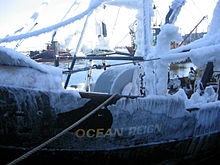Ship icing

Under ship icing is the process of freezing vessels above the waterline at air temperatures below the freezing point . Among other things, this phenomenon reduces the stability of the ship and, if it is pronounced, can endanger the ship. A distinction is made between two types of ship freezing, spray water freezing caused by seawater and freshwater freezing.
Splash water icing occurs when the air temperature is below the freezing point of the sea water and splashing water, possibly also spray , freezes on parts of the surface hull. The type and amount of ice formation depends on various factors. The most important of these are the air and water temperature, the salinity of the water, wind strength and swell and the speed and behavior of the ship in the sea. For seagoing vessels, from a temperature of −2 ° Celsius and a wind force of 5 Beaufort, it is assumed that there is beginning, from 7 Beaufort on moderate and from 8 Beaufort on strong ship icing, whereby lower temperatures accelerate the icing. Countermeasures include reducing the speed of travel, changing course and chipping off the ice.
Freshwater icing , also known as “black frost”, occurs at temperatures below freezing due to sea smoke , fog or rain. The icing from fresh water forms a harder layer of ice that is more difficult to knock off than the icing from spray water.
The icing over of the surface vessel leads to a number of hazards. The increase in mass caused by ice (ice load) reduces the freeboard and the stability of the ship. Uneven icing can lead to trimming and heeling . The icing hinders all work on deck, especially the handling of deck machinery. In addition, navigation lights and rescue equipment freeze.
literature
- Helmers, Walter (ed.): Müller-Krauss, manual for ship management . Volume 2, Maneuvering, Part A. Springer Verlag, Berlin 1988, ISBN 3-540-17939-9 , pp. 186 .
